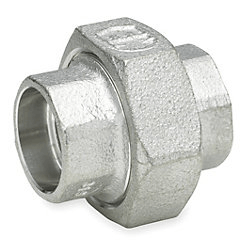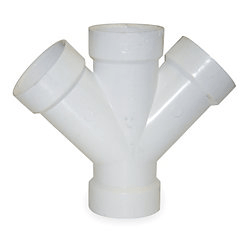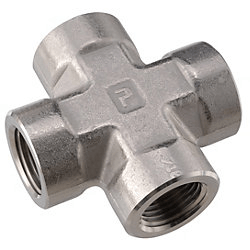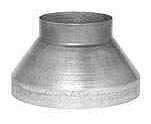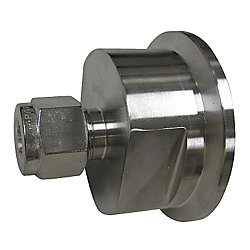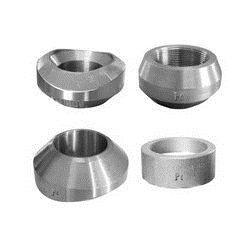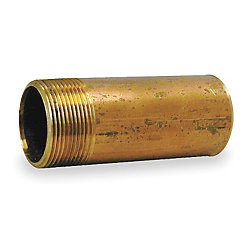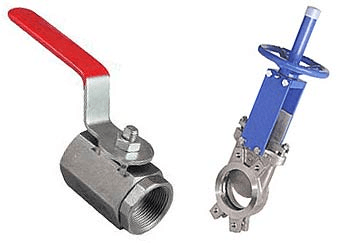Pipe Fittings Information
 Pipe fittings are parts that connect pipe sections together or to other components in in-line, offset, multi-port, or mounting configurations.
Pipe fittings are parts that connect pipe sections together or to other components in in-line, offset, multi-port, or mounting configurations.
Piping vs. Tubing and Hose
To begin, it may be important to distinguish some terminology. In industry, "tube" and "pipe" are nearly interchangeable terms. Both describe long hollow cylinders of uniform material with a certain amount of rigidity and permanence. This is in contrast to a "hose", which is typically more portable and flexible, and is made up of multiple layers of different materials that vary based on the application.
The difference between tubes and pipes is in how they are specified. Generally, pipes and their fittings are defined with nominal rather than exact dimensions. In other words, a nominal pipe size of 1.5" has an actual outside diameter of 1.900", and the wall thickness (and subsequently inner diameter) varies based on the pipe's 'schedule' (defined in the size section below). This is not the case with tubes, where the actual and rated dimensions are often the same.
In addition, pipes are almost always (with some exceptions) used for fluid transport (either pneumatic or hydraulic). Conversely, tubes can also be associated with structural applications.
Types of Fittings
 Pipe fittings are distinguished based on the connection types and functions they perform.
Pipe fittings are distinguished based on the connection types and functions they perform.
Connection Type
Fittings are attached to pipes via a number of different connection methods, each with its own conveniences and advantages.
Compression Fittings
Compression fittings are fittings which connect pipees using compression on a gasket, ring, or ferrule. The compression is typically made by tightening a nut onto the fitting over the piping and ferrule, compressing, and securing the piping inside. Standard compression fittings do not require tools to assemble, making them convenient for quick, simple installation. However, they cannot withstand very high pressures and do not have as much flexibility as soldered fittings, making them less functional in systems with vibration, thermal cycling, and other dynamic forces. They also come in a limited number of materials (most commonly brass) and are best suited for metal on metal connections.
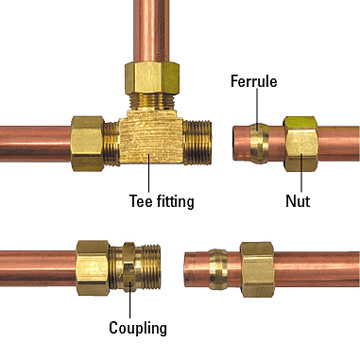
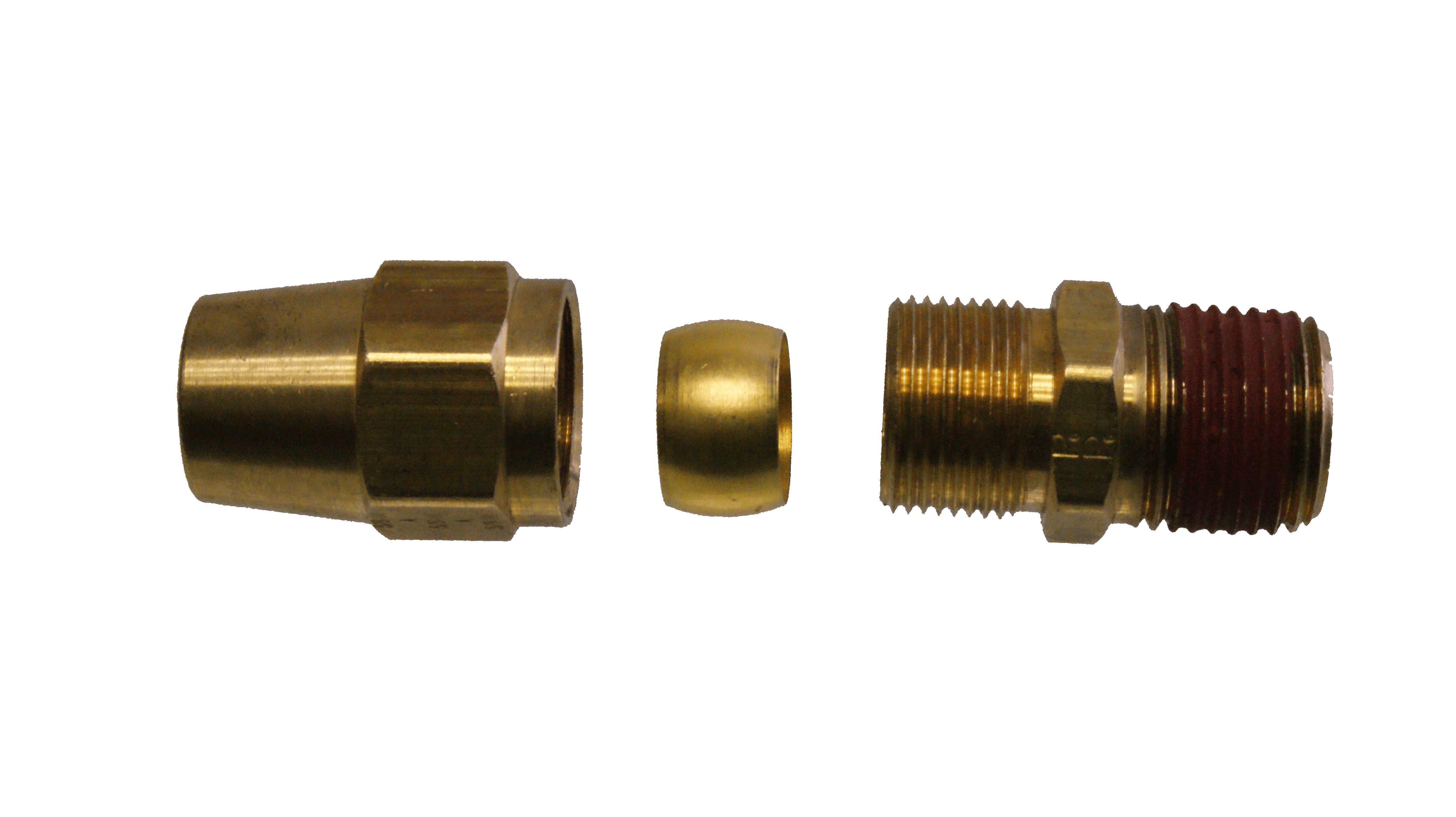
Image Credit: DIYadvice.com | Hose & Fittings, Etc.
- Bite-type fittings are compressive fittings with a sharpened ferrule that "bites" the pipe when compressed and provides the seal. Bite-type fittings, like standard compressive fittings, require no special tools to assemble, but provide a stronger, higher pressure connection.
- Mechanical grip fittings are two-ferrule assemblies. The back ferrule grips the piping while pressing up against the front ferrule, which spring-loads the front ferrule and creates a seal between the piping and fitting body. These fittings can be reassembled multiple times without damaging components or piping. They have good resistance to mechanical vibration.
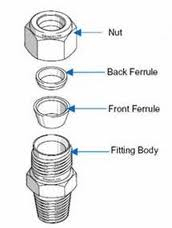
Image Credit: Valvefittingtube.com
- Flare fittings consist of a body with a flared or coned end. Special flaring tools are used to install the pipe inside the flared end, providing a deep seal. Flare fittings can handle higher pressures and a wider range of operating parameters than standard compression fittings.
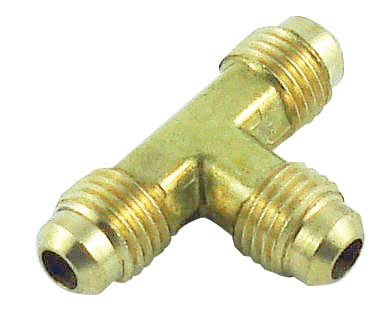
Image Credit: ChiCompany
End Fittings
End fittings provide specific surfaces for connecting pipes.
- Clamp ends are fittings which allow pipes to be clamped to the connection.
-
Plain ends are fittings which allow pipes to be connected by adhesive, solder, welding, or other means.
Flange Fittings
Flange fittings are rims, edges, ribs, or collars with flush surfaces perpendicular to the attached pipe. These surfaces are joined and sealed via clamps, bolts, welding, brazing, and/or threading. For more information on flanges, visit the Pipe Flanges Selection Guide on GlobalSpec.


Image Credit: Watts
Threaded Fittings
Threaded fittings have screw threads (built-in grooves) on their inner (female) or outer (male) surfaces designed to accept piping with matching threads. Threads which provide a simple connection but no seal are called straight threads. Tapered threads are designed to provide a tight seal for gases or fluids under pressure. Seal reliability can be improved by adding a coating or seal tape (Teflon). Especially precise threads are called "dry fit", meaning they seal without the need for an additional sealant, which is important in applications where sealant addition could cause contamination or corrosion.
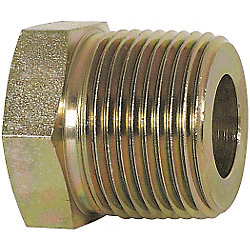
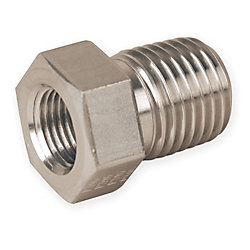
Image Credit: Grainger Industrial Supply
The thread size is measured and based on the inside of the pipe. Common thread size standards include NPT (National Pipe Thread) and BSP (British Standard Pipe), though other standards exist and usage often varies by country and industry. Each standard corresponds to a particular number of threads per inch (TPI). Plumbingsupply.com provides an excellent overview on pipe thread sizing. Below is a chart depicting nominal thread sizes and their corresponding values.
|
OD |
OD Actual |
Thread Designation - Nominal Size |
Thread per inch |
|
|
(fraction inch) |
(inches) |
(inches) |
NPT |
BSP |
|
5/16 |
0.3125 |
1/16 |
27 |
28 |
|
13/32 |
0.405 |
1/8 |
27 |
28 |
|
35/64 |
0.540 |
1/4 |
18 |
19 |
|
43/64 |
0.675 |
3/8 |
18 |
19 |
|
27/32 |
0.840 |
1/2 |
14 |
14 |
|
1-3/64 |
1.050 |
3/4 |
14 |
14 |
|
1-5/16 |
1.315 |
1 |
11-1/2 |
11 |
|
1-21/32 |
1.660 |
1-1/4 |
11-1/2 |
11 |
|
1-29/32 |
1.900 |
1-1/2 |
11-1/2 |
11 |
|
2-3/8 |
2.375 |
2 |
8 |
11 |
|
2-7/8 |
2.875 |
2-1/2 |
8 |
11 |
|
3-1/2 |
3.5 |
3 |
8 |
11 |
|
4 |
4.0 |
3-1/2 |
8 |
11 |
|
4-1/2 |
4.5 |
4 |
8 |
11 |
|
5-5/8 |
5.563 |
5 |
8 |
11 |
|
6-5/8 |
6.625 |
6 |
8 |
11 |
Function
There are a vast number of types of fittings installed in piping systems which perform different functions. Most fittings can be grouped into one of four categories:
|
Fittings which extend or terminate pipe lengths: |
||
|
Adapter |
Connects two dissimilar pipes to each other via solvent welding, soldering, or threading. |
Image Credit: GE Oil and Gas |
|
Coupling |
Connects two similar pipes to each other via solvent welding, soldering, or threading. |
Image Credit: GE Oil and Gas |
|
Sleeve |
Connect two pipes to each other using mechanical fasteners (e.g. screws, anchors). Installation is typically quicker and simpler than a soldered or welded coupling connection. |
Image Credit: Kee Safety Inc. |
|
Union |
Couplings which can be disconnected without cutting. Their connection (typically threaded) allows for easy release. |
Image Credit: Grainger Industrial Supply |
|
Cap |
Covers the end of a pipe, attaching to a male connection via a weld, thread, solvent, or solder. |
Image Credit: Full Supply Ltd. |
|
Plug |
Closes off the end of a pipe, attaching to a female connection via a weld, thread, solvent, or solder. |
Image Credit: Parker Hannifin |
|
Fittings which add or change direction: |
||
|
Elbow |
Changes the direction of the piping to various angles. The most common angles are 90 and 45, but 22.5 elbows are also made. |
Image Credit: Parker Hannifin |
|
Tee |
Connects three pieces of piping in a T-shaped intersection. This allows fluid flow to be combined or split apart. |
Image Credit: Parker Hannifin |
|
Wye |
Connects three pieces of piping in a Y-shaped intersection. They combine or split apart fluid flow like tees, but with less resistance. |
Image Credit: Grainger Industrial, Inc. |
|
Cross |
4-way connections, providing one inlet and three outlets or vice versa. Crosses are less steady than tees, and can generate high stress on the pipe with temperature changes. |
Image Credit: Parker Hannifin |
|
Fittings which connect pipes of smaller size: |
||
|
Reducer |
Includes all connections which connect between two or more pipes of different sizes. |
Image Credit: thepipefittings.com | Grainger Industrial Supply |
|
Olet |
Reduction fitting attached to branched connections when adequate reducing tees or crosses are not available. |
Image Credit: Swagat Steel & Alloys |
|
Fittings which provide special connections or functions: |
||
|
Nipple |
Allows two separate fittings to be connected at each end. Standard nipples are straight with male threads on both ends. |
Image Credit: Grainger Industrial Supply |
|
Valve |
Connects pipes together with the addition of a valve for the control of flow. For more information on types of valves, visit the Industrial Valves Selection Guide on GlobalSpec. |
Image Credit: thepipefittings.com |
Specifications
Sizing
Once the type of fitting required has been determined, the most fundamental aspect of pipe fitting can be addressed: proper sizing. Proper sizing is essential to successful fitting selection, as oversized or undersized parts will either be completely incompatible or will seal or connect inadequately.
Sizes for fittings are typically given in millimeters (mm) or inches (" or in) depending on the system of measurement. Proper sizing requires the user to select a fitting which is sized using a system of measurement (Metric or English) that is compatible with the equipment or assemby being fitted.
The sizing of a pipe fitting is defined by the size of the pipe(s) it connects to. Pipe sizes are typically described by a nominal pipe size and schedule number. Nominal pipe size correlates to an outside diameter and schedule determines the specific wall thickness (which defines the inner diameter).
The chart below encompasses standard pipe schedule and pipe sizes as given by ANSI / ASME and API 5L:
ANSI - American National Standards Institute
ASME - American Society of Mechanical Engineers
API - American Petroleum Institute
|
Nominal Size (inches) |
O.D. (inches) |
Pipe Schedule |
|||||||||||||||
|
5s |
5 |
10s |
10 |
20 |
30 |
40s & Std.* |
40 |
60 |
80s & E.H.* |
80 |
100 |
120 |
140 |
160 |
Dbl. E.H.* |
||
|
Wall Thickness (Inches) |
|||||||||||||||||
|
1/8 |
.405 |
|
.035 |
.049 |
.049 |
|
|
.068 |
.068 |
|
.095 |
.095 |
|
|
|
|
|
|
1/4 |
.540 |
|
.049 |
.065 |
.065 |
|
|
.088 |
.088 |
|
.119 |
.119 |
|
|
|
|
|
|
3/8 |
.675 |
|
.049 |
.065 |
.065 |
|
|
.091 |
.091 |
|
.126 |
.126 |
|
|
|
|
|
|
1/2 |
.840 |
.065 |
.065 |
.083 |
.083 |
|
|
.109 |
.109 |
|
.147 |
.147 |
|
|
|
.187 |
.294 |
|
3/4 |
1.050 |
.065 |
.065 |
.083 |
.083 |
|
|
.113 |
.113 |
|
.154 |
.154 |
|
|
|
.218 |
.308 |
|
1 |
1.315 |
.065 |
.065 |
.109 |
.109 |
|
|
.133 |
.133 |
|
.179 |
.179 |
|
|
|
.250 |
.358 |
|
1 1/4 |
1.660 |
.065 |
.065 |
.109 |
.109 |
|
|
.140 |
.140 |
|
.191 |
.191 |
|
|
|
.250 |
.382 |
|
1 1/2 |
1.900 |
.065 |
.065 |
.109 |
.109 |
|
|
.145 |
.145 |
|
.200 |
.200 |
|
|
|
.281 |
.400 |
|
2 |
2.375 |
.065 |
.065 |
.109 |
.109 |
|
|
.154 |
.154 |
|
.218 |
.218 |
|
|
|
.343 |
.436 |
|
2 1/2 |
2.875 |
.083 |
.083 |
.120 |
.120 |
|
|
.203 |
.203 |
|
.276 |
.276 |
|
|
|
.375 |
.552 |
|
3 |
3.500 |
.083 |
.083 |
.120 |
.120 |
|
|
.216 |
.216 |
|
.300 |
.300 |
|
|
|
.437 |
.600 |
|
3 1/2 |
4.000 |
.083 |
.083 |
.120 |
.120 |
|
|
.226 |
.226 |
|
.318 |
.318 |
|
|
|
|
.636 |
|
4 |
4.500 |
.083 |
.083 |
.120 |
.120 |
|
|
.237 |
.237 |
.281 |
.337 |
.337 |
|
.437 |
|
.531 |
.674 |
|
4 1/2 |
5.000 |
|
|
|
|
|
|
.247 |
|
|
.355 |
|
|
|
|
|
.710 |
|
5 |
5.563 |
.109 |
.109 |
.134 |
.134 |
|
|
.258 |
.258 |
|
.375 |
.375 |
|
.500 |
|
.625 |
.750 |
|
6 |
6.625 |
.109 |
.109 |
.134 |
.134 |
|
|
.280 |
.280 |
|
.432 |
.432 |
|
.562 |
|
.718 |
.864 |
|
7 |
7.625 |
|
|
|
|
|
|
.301 |
|
|
.500 |
|
|
|
|
|
.875 |
|
8 |
8.625 |
.109 |
.109 |
.148 |
.148 |
.250 |
.277 |
.322 |
.322 |
.406 |
.500 |
.500 |
.593 |
.718 |
.812 |
.906 |
.875 |
|
9 |
9.625 |
|
|
|
|
|
|
.342 |
|
|
.500 |
|
|
|
|
|
|
|
10 |
10.750 |
.134 |
.134 |
.165 |
.165 |
.250 |
.307 |
.365 |
.365 |
.500 |
.500 |
.593 |
.718 |
.843 |
1.000 |
1.125 |
|
|
11 |
11.750 |
|
|
|
|
|
|
.375 |
|
|
.500 |
|
|
|
|
|
|
|
12 |
12.750 |
.156 |
.165 |
.180 |
.180 |
.250 |
.330 |
.375 |
.406 |
.562 |
.500 |
.687 |
.843 |
1.000 |
1.125 |
1.312 |
|
|
14 |
14.000 |
.156 |
|
.188 |
.250 |
.312 |
.375 |
.375 |
.437 |
.593 |
.500 |
.750 |
.937 |
1.093 |
1.250 |
1.406 |
|
|
16 |
16.000 |
.165 |
|
.188 |
.250 |
.312 |
.375 |
.375 |
.500 |
.656 |
.500 |
.843 |
1.031 |
1.218 |
1.437 |
1.593 |
|
|
18 |
18.000 |
.165 |
|
.188 |
.250 |
.312 |
.437 |
.375 |
.562 |
.750 |
.500 |
.937 |
1.156 |
1.375 |
1.562 |
1.781 |
|
|
20 |
20.000 |
.188 |
|
.218 |
.250 |
.375 |
.500 |
.375 |
.593 |
.812 |
.500 |
1.031 |
1.280 |
1.500 |
1.750 |
1.968 |
|
|
24 |
24.000 |
.218 |
|
.250 |
.250 |
.375 |
.562 |
.375 |
.687 |
.968 |
.500 |
1.218 |
1.531 |
1.812 |
2.062 |
2.343 |
|
|
26 |
26.000 |
|
|
|
.312 |
.500 |
|
.375 |
|
|
.500 |
|
|
|
|
|
|
|
28 |
28.000 |
|
|
|
312 |
.500 |
.625 |
.375 |
|
|
|
|
|
|
|
|
|
|
30 |
30.000 |
.250 |
|
.312 |
.312 |
.500 |
.625 |
.375 |
|
|
.500 |
|
|
|
|
|
|
|
32 |
32.000 |
|
|
|
.312 |
.500 |
.625 |
.375 |
.688 |
|
.500 |
|
|
|
|
|
|
|
34 |
34.00 |
|
|
|
.312 |
.500 |
.625 |
.375 |
.688 |
|
|
|
|
|
|
|
|
|
36 |
36.000 |
|
|
|
.312 |
|
.625 |
.375 |
.750 |
|
.500 |
|
|
|
|
|
|
*Std. - Standard weight, E.H. - Extra heavy, Dbl E.H. - Double extra heavy. Table Credit: Engineers Edge
Operation
Appropriate temperature and pressure ratings are needed for proper operating conditions.
- Operating pressure range is the working range of pressures or the pressure ratings at which the fitting was designed to operate, typically measured in pounds per square inch (psi). Operating above or below this rating could cause the fitting to fail (i.e. break, leak, lose its seal).
- Operating temperature range is the working range of temperatures or the temperature ratings at which the fitting was designed to operate, measured in degrees Fahrenheit (°F) or degrees Celsius (°C). Operating above or below this rating could cause the fitting to fail.
Materials
The materials for pipe fittings are often selected alongside the materials for the piping. Selection depends on factors such as cost, flexibility, media, environmental conditions, and required pressure ratings. Material choices include different types of plastic or metal.
Common metals include:
- Aluminum - lightweight and corrosion resistant. Aluminum is commonly used for plumbing and is the preferred fitting material for aluminum piping. By itself, aluminum has low tensile strength and is used when high corrosion resistance is needed. It is alloyed with zinc, copper, silicon, manganese, and/or other metals to improve its strength and hardness.
- Brass - strong, durable, and corrosion resistant, with high temperature ductility and good conductivity. Brass is an alloy of copper and zinc, and is commonly used for smaller compression and threaded pipe fittings in industry because of its machinability and its excellent performance properties. Brass fittings can have various protective or decorative finishes which should match the finish of the piping.
- Cast iron - strong and highly abrasion resistant. Cast iron fittings and pipes are used primarily in building construction for sanitary, storm drain, waste, and vent piping applications because of their resistance to abrasive materials like sand, gravel, solid wastes, and debris.
- Copper - extremely corrosion resistant with excellent conductivity. Copper fittings are important for many plumbing and heating applications, and are commonly used for residential water supply lines. Copper fittings are usually used in conjunction with copper piping, and come in either soft or rigid forms. Soft or ductile copper is easily bent and maneuvered, and is the only type suitable for flare connections. Rigid copper is not bendable and requires directional fittings to go around corners and obstacles.
- Steel - durable and strong, with a high resistance to heat. Steel is an alloy of iron and carbon; it is commonly alloyed with other metals to improve its corrosion resistance and durability. It is used in both commercial and industrial applications for carrying water, flammable gases, and other fluids. Galvanized steel is coated with zinc for rust and chemical corrosion resistance. Carbon steel is alloyed with higher levels of carbon for increased durability and strength.
- Stainless steel - relatively strong with excellent chemical and corrosion resistance. Stainless steel is an alloy of steel that contains over 10.5% chromium, providing excellent corrosion resistance for sanitary applications and those dealing with aggressive fluids and materials.
Common plastics include:
- PVC (poly-vinyl-chloride) - a common plastic for pipe fittings. PVC is a rigid plastic which can come in a variety of pressure ratings. Fittings are connected via threads or solvent welding (glue). Standard applications include cold water supply and drainage.
- ABS (acrylonitrile butadiene styrene) - black and rigid plastic with similar properties and applications to PVC, but typically more economical.
- Polyethylene (PE) - the most preferred plastic for hot and cold temperature applications. PE is grey or black, semi-flexible plastic. Fittings are used commonly for supply lines to sprinkler systems and underground geothermal heating loops.
- Polypropylene (PP) - thermoplastic material that exhibits excellent cold flow, bi-axial strength, and yield elongation properties. It is similar to PVC, but can be used in exposed applications because of its resistance to UV, weathering, and ozone.
- Nylon - plastic with high chemical and corrosion resistance. It is the preferred plastic for applications involving flammable fluids, chemical solvents, and potable water.
Selection Tip: It is essential to check the compatibility of the system fluid with any proposed fitting materials. Incompatibility could result in corrosion causing leakage or system damage.
References
Engineering Toolbox — Pipes & Tubes
Pipe Fittings & Flanges — Pipe Fitting Selection Guide
Images Credits
Main Manufacturing, Inc. | GE Oil and Gas
- Alabama
- Arkansas
- Arizona
- California
- Colorado
- Connecticut
- District of Columbia
- Delaware
- Florida
- Georgia
- Hawaii
- Iowa
- Illinois
- Indiana
- Kansas
- Kentucky
- Louisiana
- Massachusetts
- Maryland
- Maine
- Michigan
- Minnesota
- Missouri
- Montana
- North Carolina
- Nebraska
- New Hampshire
- New Jersey
- New Mexico
- Nevada
- New York
- Ohio
- Oklahoma
- Oregon
- Pennsylvania
- Rhode Island
- South Carolina
- Tennessee
- Texas
- Utah
- Virginia
- Washington
- Wisconsin
- Wyoming
- Adapter
- Aluminum
- Brass/Bronze
- Bulkhead Fitting
- Carbon & Alloy Steel
- Clamp End
- Copper
- Coupling
- Cross / 4-Way
- Elbow
- End Bell
- English
- Exotic Metals
- Flange
- Flange
- Fluororesin (PFA/PTFE/PVDF)
- Iron (Cast/Ductile)
- Metric
- Nipple
- PVC/CPVC
- Polyethylene (PE)
- Polypropylene (PP)
- Reducer
- Rubber / Elastomer
- Stainless Steel
- Swivel
- Tee
- Threaded
- Union
- Weld
- Wye
- ABS pipe fittings
- stainless steel barb fitting
- cajon fittings catalogue
- pipe fittings CAD
- stainless steel pipe fittings
- clay valve
- eccentric reducer
- schedule 40 pipe diameter
- tank bulkhead fitting
- threaded pipe reducer
- pipe reducer
- AutoCAD blocks pipe fitting
- ductile iron pipe fitting
- galvanized pipe fitting
- PVC pipe pressure rating
- steel pipe fitting dimensions
- luer thread dimension
- flange dimension
- luer fitting standards drawing
- SS bulkhead fitting
- Backshell
- brass bulkhead fitting
- steel pipe reducer
- 1 inch brass compression fitting
- 90 degree elbow
- ANSI flanges
- kimax pipe
- ladish fitting pipe
- obac fitting
- plumbers fitting organizer



